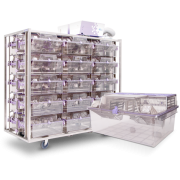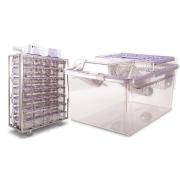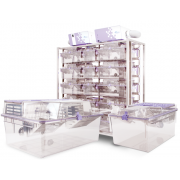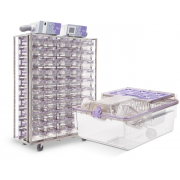Caging systems - Allentown's IVC
US manufacturer of animal facility solutions Allentown sells equpiment for animal facility since 1968. In the last 30 years has installed over 20 000 IVC racks that have been and are used for the breeding of more than 12 000 000 laboratory animals.
What distinguishes Allentown?
First of all, striving to continuously optimize their systems by raising the standards of biosecurity, resulting in cheaper operating costs for customers.
What Allentown is the most famous?
Allentown world's first used polysulfone (PSU) for the production cages for laboratory rodents. As a result, polysulfone spread as a very durable material - resistant to thousands of washing and autoclaving cycles. PSU cages save customers frequent replacement costs of cages made of less resistant materials. With proper usage PSU cages can be use continuously for 6-8 years.
Allentown introduced in the design of IVC racks innovation on a large scale involving the use of air flow at the cage level (ACL). Air is forced through a special, stainless steel diffuser. With a few diffuser holes air is uniformly dispersed over the entire width of the cage bottom.
Such a solution is effective for:
- dry bedding
- effectively reduce the level of ammonia and carbon dioxide
- stop the formation of dead spots, where does not reach the air in a cage
- use no more than 60 air changes per hour (max. 60 ACH) on IVC
Allentown is not just a product, but an effective solution adjusted to the requirements of science.
IVC racks meet all of the scientific community guidelines for air flow and number of air changes, vibration and noise, as well as the parameters of ammonia and CO2 in the cages.
Velocity and air flow
Innovative solution of air flow at the cage level is efficient and causes the amount of air changes max. 50-60 ACH depending on the type of system Allentown IVC. Independent research institution TUV confirmed that:
- air velocity is in accordance with the guidelines TIZ-BIFO and is less than 0.2 m / s.
Therefore:
- ventilation at the cage level affect the drying of bedding and reduce the concentration of ammonia and CO2
- the air is effectively dispersed to the entire surface of cage bottom without causing a "dispatch" by using a matched, stainless steel diffuser made equpied with special holes distracting inlet air
- 50 air changes per hour (ACH) is sufficient for proper air delivery for animals. Greater IVC racks operates at a maximum of 60 ACH.
no more ACH = no more energy = cheap operating costs.
The noise of blowers in Allentown's IVC
Currently Allentown equips his blowers in very quiet engines ECM. So that the noise level in the single IVC racks is 20 dB, whereas in the few-rack-systems not exceed 50 dB.
The maximum noise level in EcoFlo units:
- 20 dB - blower mounted on rack (only for 1 singlesided rack)
- 48 dB - tower blower (for 4 singlesided racks or 2 doublesided racks).
Listen EcoFlo:
Vibrations of IVC rack Allentown?
EcoFlo blower units in Allentown IVC racks generate vibrations indistinguishable from the surrounding environment. The vibration level has been tested in the IBM laboratory and was estimated at 0.006 - 0.030 g transmitted to the bottoms of cages in IVC racks. It should be noted that the vibration of the surrounding environment (at rest) are 0.004 - 0.020 g. In this regard, the vibrations Allentown IVC racks do not have any substantial effect on animal welfare.
Allergens
All Allentowns blower units are equipped with pre-filters, final-filters and main HEPA H14, retaining 99.995% of particles of allergens as small as 0.3 microns.
HEPA14 filters installed in IVC racks, transfer stations and bedding disposal stations safe animal facility staff to effectively protect against allergens.
What else?
IVC racks manufactured by Allentown meet all norms of airflow, noise, vibration and allergens. Thanks to an innovative solution of air flow at the cage level and the optimized design Allentown guarantee better protection for animals and animal facility staff.





